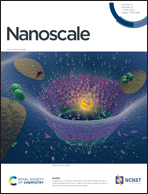Graphene oxide as a dual template for induced helicity of peptides†
Abstract
Artificial template-mediated fabrication of secondary structures within peptides always attracts great interest in biological systems due to several biomimetic interactions. In all earlier studies, a uniform template containing molecules/nanomaterials was used to target only one type of peptide at a time, which extensively limits the diversity in the generation of artificial protein surface/binding sites. This limitation can be overcome by the incorporation of more than one binding template (heterogeneity) in a single system, for example, Janus nanomaterials, which are challenging and difficult to synthesize. In this context, graphene oxide (GO) is considered an artificial binding site (template). It contains two distinctive binding zones, i.e., surface and edge, which can induce the secondary structure of peptides based on complementary interactions. To establish our concept, we have implemented a hybrid sequence i.e., i, i + 4, i + 7 and i + 11 pattern peptides, which defines a more linear surface, suitable for recognition by the two-dimensional GO. Depending on the amino acid residue at the specific locations, we observed substantial enhancement of peptide helicity either at the surface or at the edges of GO from the random coil. However, non-interacting peptides remain as a random coil. We have established this by circular dichroism study at various conditions, as well as atomic force microscopy and optical imaging study. Furthermore, we have also established our observations using molecular dynamics (MD) simulations. This study reveals that the synthesized GO-peptides composite with different secondary structures and recognition residues can mimic biological systems.



 Please wait while we load your content...
Please wait while we load your content...